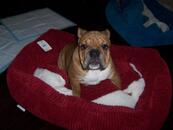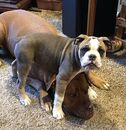RedmondLiving
New member
http://www.petmd.com/dog/care/evr_hot_spots_what_are_they
Hot Spots are one of those less then desirable skin irritations seen in pets. Often, you'll here your vet refer to them as moist eczema, but you ... well, you can call them hot spots. They occur when your dog itches, scratches or licks him or herself excessively, eventually forming a wet scab on the fur. But what do you with a hot spot?
Hot Spots (also known as Summer Sores or Moist Eczema) can seemingly appear spontaneously anywhere on a dog's body; the surrounding area can rapidly deterioriate too. This moist, raw skin disorder has a variety of causes but the most consistent factor is bacteria.
Anything that irritates or breaks the skin can create the environment for bacterial contamination if the surface of the skin has but only a little a bit of moisture on it. Such incidences of moisture can be such seeminly innocuous things such as as a recent bath, swim, stroll in the rain, or playtime in wet craze. Even a slightly oozing sore can provide enough moisture and/or nutrient for a bacterial infection to take hold.
Although there are various types of "hot spot"-causing bacteria, most respond to oral and topical antibiotics. For some reason, cats rarely acquire hot spots.
[h=3]How to treat a Hot Spot[/h]
1. Trim the area around the hot spot with animal clippers. If the area is too big, shave it. Exposing it to air will dry out the moisture and help speed healing.
2. Clean the area with a mild water-based astringent or antiseptic spray, or specialized shampoo, and pat dry.
3. Apply hydrocortisone spray or hydrocortisone cream (with a veterinarian's prescription) to stop the itching and help promote healing.
4. Prevent your dog from biting, licking or scratching the hot spot affected area. Placing an Elizabethan collar (plastic cone) around your dog's neck, for example, can be an excellent tool to keep him/her from biting and licking at it.
5. Keep an eye on the area to make sure it continues to heal and doesn't worsen or spread. Hot spots often require a visit to the vet, who will likely prescribe topical medication usually in the form of a Gentamicin / Betamethasone spray, and possibly oral antibiotics. The vet may also give your dog a cortisone injection to jump start the healing process.
--
Below is a view of a minor Hot Spot. But even this little lesion could spread rapidly and become severe.
[h=3]A Typical Hot Spot... and How To Treat It[/h]Click on an image to enlarge in a new window
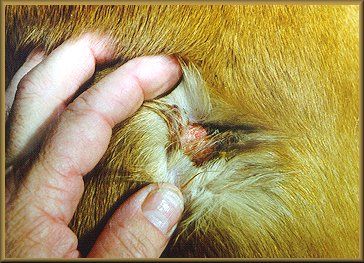
In this photo we can see -- now that the fur has been parted -- the raw, weeping circular hot spot. These often spread under the cover of the fur so that by the time you notice them they are well established and spreading. This particular case of moist eczema may have been caused by a tick bite. The fur is shaved over the moist eczema to facilitate application of medication as well as to allow drying.
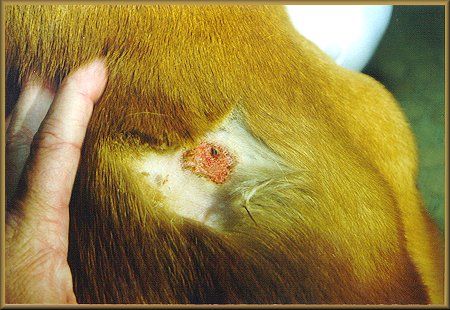
The area surrounding the hot spot lesion should be shaved. That tiny black spot at the top of the hot spot is an area where the skin has actually died and may be where a tick was attached. Why one tick will trigger moist eczema and others won't is still a mystery. If every tick bite caused this much reaction, the magnitude of skin problems in dogs would be staggering!
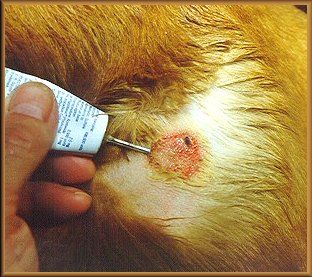
Daily cleaning of the hot spot, even every two hours for the first day or two, will speed up the healing. Also, any topical anti-bacterial ointment will arrest the growth of the bacteria. These skin lesions can take a week to finally dry and look like they are going to heal. Once they are no longer oozing, simply keeping the hot spot area clean will be all that's needed. The fur begins to grow back (sometimes a different color!) within two weeks.
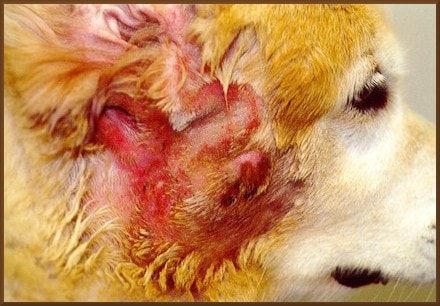
This severe case of active moist eczema on a Golden Retriever (different from the case displayed above) shows how extensive the infection can be and the degree of damage a hot spot can do to the skin of a dog. This case has been shaved and cleaned; vigorous treatment with antibiotics and cleansers is started. Rarely will a scar be a consequence of Hot Spots but scarring can happen.
[h=3]Hot Spots, Moist Eczema, and Summer Sores[/h]
Here are a few more things you might not have known about hot spots, moist eczema and summer sores. They really do seem much more prevalent in the summer months. They can cause severe itching and self-trauma because the infection goes into the deep layers of the skin. This is why hot spots may take two weeks to finally look like they are going to heal. On occasion if a dog has extensive and deep areas of Moist Eczema, oral antibiotics and antihistamines may need to be prescribed and large areas of skin will be shaved
Keep your dog well groomed, especially in hot seasons. Any dog that has matted, dirty hair coat is at greater risk of developing hot spots. Many owners will have their long or thick-furred dog shaved closely in the summer. You can do this yourself -- carefully, of course -- by using animal clippers, especially around the ears and where there is thick fur that doest dry quickly. This really does help prevent the thick coat from covering any dampness on the surface of the skin. If the fur is allowed to accumulate too much moisture, the wet skin underneath can become the perfect breeding ground for bacterial growth and hot spots.
And though they mostly occur in the summertime, hot spots can develop at any time. If your dog develop a skin lesion, call your veterinarian immediately. Do not delay! You may run the risk that your dog's condition deterioates quickly (see below).
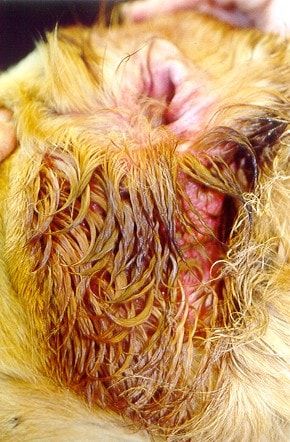
This Golden Retriever developed a hot spot under each ear and this severe moist eczema developed in less than 24 hours! Both ears and both sides of the dog's face needed to be clipped and cleaned while under light anesthesia.
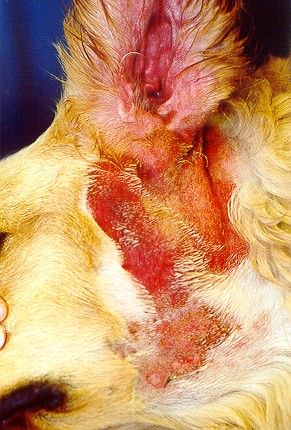
Treatment consisted of topical peroxide every two hours and systemic antibiotics to combat the deep skin infection, as well as a single, short acting corticosteroid to stop the inflammatory reaction. Oral antibiotics and topical medication are typically continued for at least a week; two weeks of the hot spot treatment is even better for the dog.
Many types of dermatological problems are avoided if your dog is on a well-balanced diet. In some cases, adding dietary supplements such omega fatty acids can help avoid repeated issues of hot spots and other skin afflictions. If your dog (or cat) seems to lack a healthy coat and/or skin, consider upgrading the diet to a meat-based ingredient formula. The first ingredient listed in on the pet food label should be a meat such as chicken, lamb, poultry, beef or fish; if it is corn...pass it up
Hot Spots are one of those less then desirable skin irritations seen in pets. Often, you'll here your vet refer to them as moist eczema, but you ... well, you can call them hot spots. They occur when your dog itches, scratches or licks him or herself excessively, eventually forming a wet scab on the fur. But what do you with a hot spot?
Hot Spots (also known as Summer Sores or Moist Eczema) can seemingly appear spontaneously anywhere on a dog's body; the surrounding area can rapidly deterioriate too. This moist, raw skin disorder has a variety of causes but the most consistent factor is bacteria.
Anything that irritates or breaks the skin can create the environment for bacterial contamination if the surface of the skin has but only a little a bit of moisture on it. Such incidences of moisture can be such seeminly innocuous things such as as a recent bath, swim, stroll in the rain, or playtime in wet craze. Even a slightly oozing sore can provide enough moisture and/or nutrient for a bacterial infection to take hold.
Although there are various types of "hot spot"-causing bacteria, most respond to oral and topical antibiotics. For some reason, cats rarely acquire hot spots.
[h=3]How to treat a Hot Spot[/h]
1. Trim the area around the hot spot with animal clippers. If the area is too big, shave it. Exposing it to air will dry out the moisture and help speed healing.
2. Clean the area with a mild water-based astringent or antiseptic spray, or specialized shampoo, and pat dry.
3. Apply hydrocortisone spray or hydrocortisone cream (with a veterinarian's prescription) to stop the itching and help promote healing.
4. Prevent your dog from biting, licking or scratching the hot spot affected area. Placing an Elizabethan collar (plastic cone) around your dog's neck, for example, can be an excellent tool to keep him/her from biting and licking at it.
5. Keep an eye on the area to make sure it continues to heal and doesn't worsen or spread. Hot spots often require a visit to the vet, who will likely prescribe topical medication usually in the form of a Gentamicin / Betamethasone spray, and possibly oral antibiotics. The vet may also give your dog a cortisone injection to jump start the healing process.
--
Below is a view of a minor Hot Spot. But even this little lesion could spread rapidly and become severe.
[h=3]A Typical Hot Spot... and How To Treat It[/h]Click on an image to enlarge in a new window

In this photo we can see -- now that the fur has been parted -- the raw, weeping circular hot spot. These often spread under the cover of the fur so that by the time you notice them they are well established and spreading. This particular case of moist eczema may have been caused by a tick bite. The fur is shaved over the moist eczema to facilitate application of medication as well as to allow drying.

The area surrounding the hot spot lesion should be shaved. That tiny black spot at the top of the hot spot is an area where the skin has actually died and may be where a tick was attached. Why one tick will trigger moist eczema and others won't is still a mystery. If every tick bite caused this much reaction, the magnitude of skin problems in dogs would be staggering!

Daily cleaning of the hot spot, even every two hours for the first day or two, will speed up the healing. Also, any topical anti-bacterial ointment will arrest the growth of the bacteria. These skin lesions can take a week to finally dry and look like they are going to heal. Once they are no longer oozing, simply keeping the hot spot area clean will be all that's needed. The fur begins to grow back (sometimes a different color!) within two weeks.

This severe case of active moist eczema on a Golden Retriever (different from the case displayed above) shows how extensive the infection can be and the degree of damage a hot spot can do to the skin of a dog. This case has been shaved and cleaned; vigorous treatment with antibiotics and cleansers is started. Rarely will a scar be a consequence of Hot Spots but scarring can happen.
[h=3]Hot Spots, Moist Eczema, and Summer Sores[/h]
Here are a few more things you might not have known about hot spots, moist eczema and summer sores. They really do seem much more prevalent in the summer months. They can cause severe itching and self-trauma because the infection goes into the deep layers of the skin. This is why hot spots may take two weeks to finally look like they are going to heal. On occasion if a dog has extensive and deep areas of Moist Eczema, oral antibiotics and antihistamines may need to be prescribed and large areas of skin will be shaved
Keep your dog well groomed, especially in hot seasons. Any dog that has matted, dirty hair coat is at greater risk of developing hot spots. Many owners will have their long or thick-furred dog shaved closely in the summer. You can do this yourself -- carefully, of course -- by using animal clippers, especially around the ears and where there is thick fur that doest dry quickly. This really does help prevent the thick coat from covering any dampness on the surface of the skin. If the fur is allowed to accumulate too much moisture, the wet skin underneath can become the perfect breeding ground for bacterial growth and hot spots.
And though they mostly occur in the summertime, hot spots can develop at any time. If your dog develop a skin lesion, call your veterinarian immediately. Do not delay! You may run the risk that your dog's condition deterioates quickly (see below).

This Golden Retriever developed a hot spot under each ear and this severe moist eczema developed in less than 24 hours! Both ears and both sides of the dog's face needed to be clipped and cleaned while under light anesthesia.

Treatment consisted of topical peroxide every two hours and systemic antibiotics to combat the deep skin infection, as well as a single, short acting corticosteroid to stop the inflammatory reaction. Oral antibiotics and topical medication are typically continued for at least a week; two weeks of the hot spot treatment is even better for the dog.
Many types of dermatological problems are avoided if your dog is on a well-balanced diet. In some cases, adding dietary supplements such omega fatty acids can help avoid repeated issues of hot spots and other skin afflictions. If your dog (or cat) seems to lack a healthy coat and/or skin, consider upgrading the diet to a meat-based ingredient formula. The first ingredient listed in on the pet food label should be a meat such as chicken, lamb, poultry, beef or fish; if it is corn...pass it up

